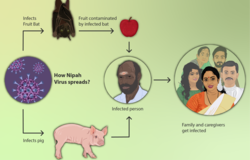Nipah virus infection
Nipah virus disease is a disease caused by the nipah (NiV) virus. This virus belongs to the Paramyxoviridae family and causes severe disease in humans. Half of all patients die. The virus is spread by fruit-eating bats. [1]
Symptoms
Symptoms of Nipah virus disease start to appear within 3-14 days of infection. When people first get this disease, it looks like some other diseases. People get fever, headache, and throat pain, and they feel very tired. They have difficulty breathing. Later, they get much sicker. They feel dizzy and might become unconscious.[2]
There have been 582 known cases of Nipah virus infection in humans. About half of these patients died.
Transmission
Fruit-eating bats can carry Nipah virus. Humans can get Nipah virus when they come in contact with items that are contaminated by infected bats' excreta.[3] In Bangladesh, people were got Nipah virus when they drank date palm toddy which was contaminated by bats.
Infected bats can also spread Nipah virus to other animals, such as pigs. In Malaysia and Singapore, people got Nipah virus from pigs that had come into contact with infected bats.
Nipah virus can transmit from people to people also. It spreads through body fluids such as saliva, blood, and urine. For this reason, the caretakers of infected people are at an especially high risk of getting Nipah virus. The virus is not known to transmit through air.
Detection
Nipah virus can be detected from throat swabs, cerebrospinal fluid (fluid taken by puncturing the spine, called a lumbar puncture), and blood tests. Scientists detect Nipah virus by finding copies of viral genome in the test sample.
After death, Nipah virus can also be identified by examining body tissues in an autopsy.
Treatment
There is no cure for Nipah virus infection. Ribavirin, a drug that fights some viruses, is possibly effective, but its effectiveness has not been well proven yet. Therefore, the usual treatment is to give supportive care, such as giving medicines to reduce fever and other symptoms. People who get very sick from Nipah virus disease may need ventilatory support.
Symptomatic treatment: focusing on managing the symptoms Government prepared to import necessary drugs if required[4]
Prevention
Avoiding contact with items contaminated by infected bats is the best way to prevent Nipah virus disease. Since the disease can spread from person to person, those in close contact with a patient must wear protective gear, including special masks, gloves and goggles. Healthcare workers in infected areas should also wear protective gear. There is currently no vaccine to prevent the disease.
Outbreaks
Nipah virus has caused disease outbreaks in several parts of the world, including Malaysia, Bangladesh, Singapore and India. In 2018, there was an outbreak of Nipah virus in Kerala, India, which was successfully contained.
Surveillance and Monitoring
- Public Awareness: Educating the public and promoting hygiene practices
- Medical Preparedness: Equipping hospitals to handle cases efficiently and safely
- Research and Development: Encouraging research for treatments and vaccines
- Contact Tracing: Identifying and monitoring individuals in contact with infected persons
- Testing Facilities: Establishing safe and accurate labs for testing
- Emergency Response Teams: Forming teams to manage outbreaks and conduct investigations
Nipah Virus Infection Media
References
- ↑ "WHO - Nipah virus infection". WHO.
- ↑ "Nipah Virus (NiV) - CDC". www.cdc.gov. 31 May 2018.
- ↑ "Transmission - Nipah Virus (NiV) - CDC". www.cdc.gov.
- ↑ Aryan, Aniket. "Kerala Viral Outbreak: Symptoms & Response. | SRIRAMs IAS". www.sriramsias.com. Retrieved 2023-09-14.




